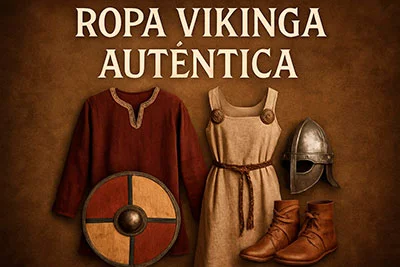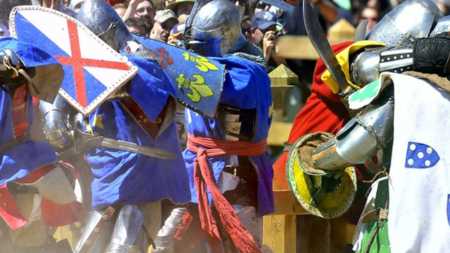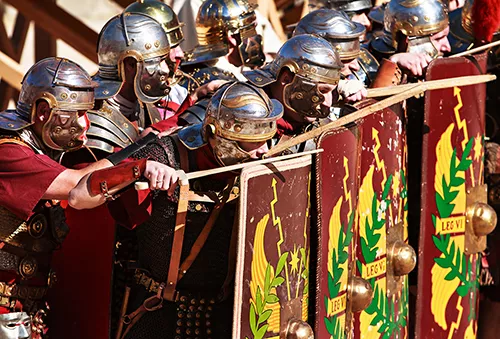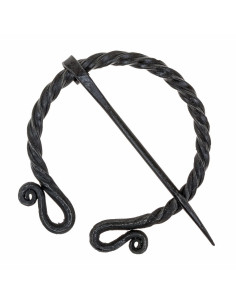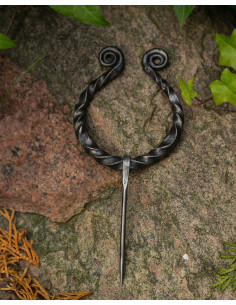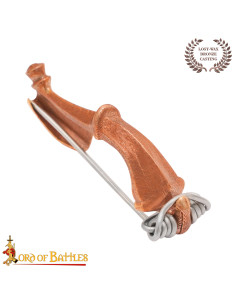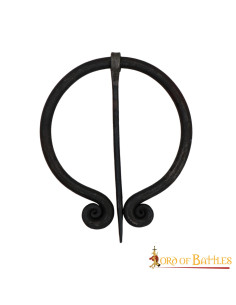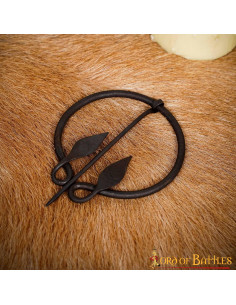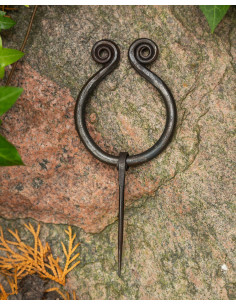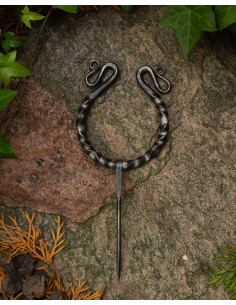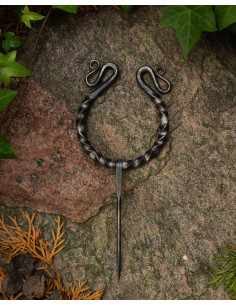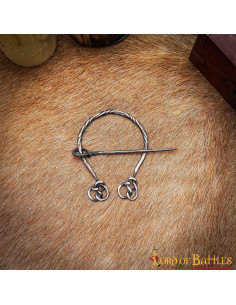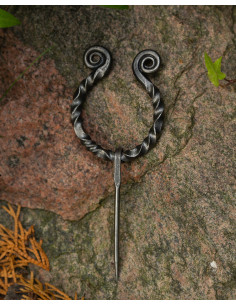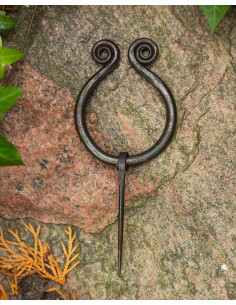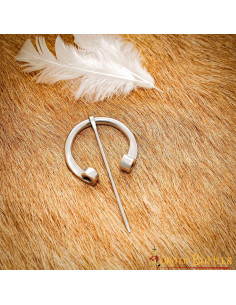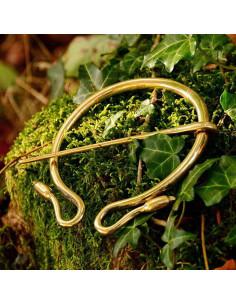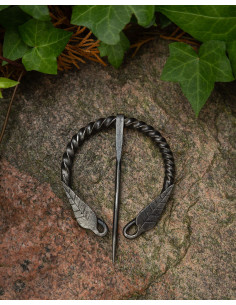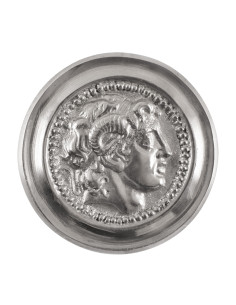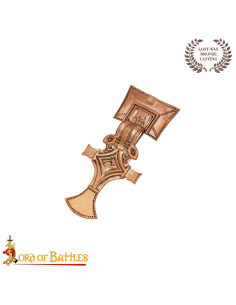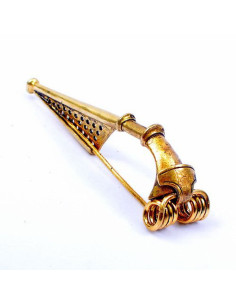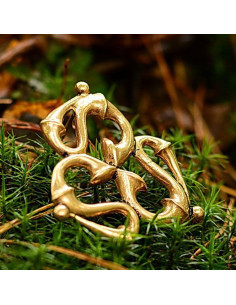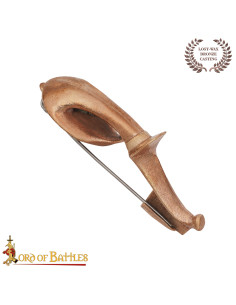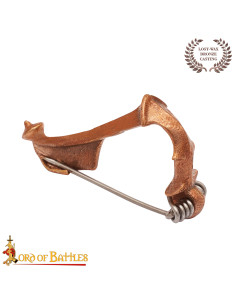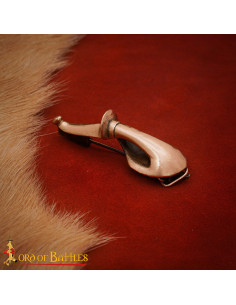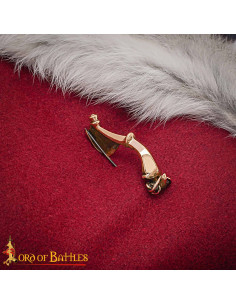Roman brooches and fibulas
Fibula for capes in polished forged steel (11x6.7 cm.)
Roman Fibula from the 1st-2nd Century in Antiqued Bronze
History and Design of Roman Brooches and Fibulae
Roman brooches and fibulae are pieces that condense centuries of history and functionality. From Roman fibulae of the 1st and 2nd centuries, such as the Roman Triquetra Fibula-Brooch, 2nd century AD, or the Roman Fibula-Brooch, 1st century, to larger designs like the Roman Omega Fibula, 2nd century AD, each model reflects the aesthetic and practical needs of the era. These brooches not only fastened cloaks and garments but also served as status symbols, with variations in size and detail that could indicate social position or military affiliation.
In our collection, it is possible to appreciate the evolution of design: simple and functional fibulae alongside ornamental pieces such as the Central Insignia for Roman Phalera (7 cm) or the Large Lyra Fibula for dresses and cloaks. The finish and casting technique determine the character of each piece: some faithfully reproduce the textures of bronze and brass, while others recreate shapes in forged or polished steel, perfect for those seeking authenticity and robustness in Roman brooches and fibulae.
Materials and Finishes: Bronze, Steel, and Iron in Roman Brooches and Fibulae
The selection of materials is key when choosing among Roman brooches and fibulae. Bronze was historically predominant, which is why pieces like the Roman Bronze Fibula (4.5x3.2 cm) and the Roman Bronze Fibula (5 cm) faithfully reproduce the aged appearance of ancient metal. For those seeking durability and a modern shine, the Roman Fibula in stainless steel (7.9x3.5 cm) or the Cloak Fibula in polished forged steel (11x6.7 cm) offer corrosion resistance and a more contemporary look without losing the classical air.
There are also pieces made of wrought iron, such as the functional wrought iron cloak brooch, which provide roughness and a handcrafted feel. The finish can vary: patinas that simulate aging, polished shine, or hammered textures. In our offer of Roman brooches and fibulae, you will find both replicas with antique patina and pieces with modern polishing, suitable for historical reenactments, theatrical use, or as fashion accessories that combine authenticity and quality.
How to Choose Roman Brooches and Fibulae According to Garment and Size
Choosing the correct brooch involves considering the garment and its function. For light dresses and cloaks, small models like the Small Lyra Fibula for dresses and cloaks, the Small Bernhard Fibula for dresses and cloaks, or the Small Angús Fibula for dresses and cloaks are ideal: they secure without adding excessive weight or deforming the fabric. On the other hand, for thick cloaks or mantles, larger fibulae such as the Large Bernhard Fibula for dresses and cloaks, the Large Angús Fibula for dresses and cloaks, or the Roman Medieval Fibula in cast bronze (7.7 cm) provide the necessary fastening power and greater aesthetic impact.
Besides size, evaluate the clasp and length: the Fibula from the Roman era (4.2x2 cm) or the Roman Bronze Fibula: length 8.5 cm show how small differences in length and pin design change the fastening. For very heavy cloaks, the Cloak Fibula in polished forged steel (11x6.7 cm) or the Medieval cloak brooch with leaf-shaped ends combine aesthetics and functionality. Take into account the thickness of the fabric, the weight of the brooch, and the visual effect you want to achieve when pairing it with your outfit.
Use and Placement: Functionality and Style of Roman Brooches and Fibulae
Roman brooches and fibulae are used both for their practical function and decorative value. Correctly placing a fibula ensures the garment stays fastened without damage: the pin must pierce the fabric at an angle that allows tension distribution and hooks into the fibula body. Models like the Roman Fibula in stainless steel (7.9x3.5 cm) or the Roman Bronze Fibula (4.5x3.2 cm) are versatile and suitable for daily use or reenactments, while more ornamental pieces, such as the Roman Triquetra Fibula-Brooch, 2nd century AD, act as focal points in the outfit composition.
Beyond fastening cloaks, these brooches serve as style elements on vests, mantles, and dresses. The traditional placement is usually on the shoulder or center of the chest for capes and mantles; on dresses, they are typically positioned at the top to keep the closure. For historical reenactments, combining a Central Insignia for Roman Phalera (7 cm) with matching fibulae provides visual coherence. We also recommend trying different positions to balance the proportion of the ensemble and highlight metallurgical details of the brooch.
Care and Maintenance of Your Roman Brooches and Fibulae
Keeping Roman brooches and fibulae in good condition prolongs their lifespan and preserves their aesthetics. For bronze pieces, such as the Roman Bronze Fibula (5 cm) or the Roman Bronze Fibula: length 8.5 cm, it is advisable to clean with a soft cloth and avoid abrasive chemical products that remove the historical patina. If the piece shows surface rust, using specific bronze cleaners or reapplying a protective layer with fine oils will help prevent corrosion without damaging the details.
For stainless steel and wrought iron, like the Cloak Fibula in polished forged steel (11x6.7 cm) or the functional wrought iron cloak brooch, periodic cleaning with a damp cloth and immediate drying to avoid persistent moisture is sufficient. Store your brooches separately in soft fabrics or individual cases to prevent scratches and bumps, and check clasps and hooks before each use to ensure they maintain their functionality. With simple care, your Roman brooches and fibulae will retain their appearance and operation for years.
Are the Roman Brooches and Fibulae Pieces You Sell Historical Replicas?
Our pieces include replicas based on historical prototypes and designs inspired by Roman tradition. Models such as the Roman Triquetra Fibula-Brooch, 2nd century AD, or the Roman Fibula-Brooch, 1st century, reproduce shapes and techniques observed in archaeological finds. The fidelity varies by model: there are faithful replicas with aged patinas and stylized versions in steel for modern use. If you seek authenticity for reenactments, consult the product descriptions that detail the process and finish.
What Materials Are Most Recommended According to the Use of Roman Brooches and Fibulae?For everyday use and greater durability, stainless steel and polished forged steel are excellent for their corrosion resistance; examples include the Roman Fibula in stainless steel (7.9x3.5 cm) and the Cloak Fibula in polished forged steel (11x6.7 cm). For historical reenactments and authentic appearance, bronze and cast bronze, such as the Roman Medieval Fibula in cast bronze (7.7 cm) or the Roman Bronze Fibula (4.5x3.2 cm), offer the patina and texture typical of antiquity. Wrought iron adds rustic character and robustness in functional brooches.
How to Choose the Correct Size Among Roman Brooches and Fibulae for My Cloak or Dress?Consider the thickness and weight of the garment: light fabrics require small fibulae like the Small Lyra Fibula for dresses and cloaks or the Small Angús Fibula for dresses and cloaks, while heavy cloaks need large pieces like the Large Bernhard Fibula for dresses and cloaks or the Large Angús Fibula for dresses and cloaks. Measure the area where you want to place the brooch and check the indicated dimensions (for example, 4.2x2 cm or 11x6.7 cm) to ensure the proportion and fastening are appropriate for the garment.
Can Roman Brooches and Fibulae Be Used as Contemporary Jewelry Pieces?Yes. Many of our fibulae work perfectly as modern fashion accessories: the Large Lyra Fibula or brooches with steel finishes can be integrated into contemporary looks, adding a historical and distinctive touch. When using fibulae as jewelry, check the clasp system and avoid very delicate fabrics that could be damaged by the pin. These brooches combine aesthetics and practicality, serving both reenactments and current styling.
How to Properly Place Roman Brooches and Fibulae to Prevent Them from Coming Loose?Correct placement is key: insert the pin at an angle that pierces several layers of fabric if possible, and ensure the end is firmly hooked into the fibula body. For cloaks, position the brooch near the shoulder or upper center of the chest to better distribute the weight. Always check the clasp before moving; if the piece is very heavy, choose a more robust fibula like the Cloak Fibula in polished forged steel (11x6.7 cm) for greater security.
What Maintenance Do Roman Brooches and Fibulae Require to Preserve Their Appearance?Maintenance varies by material: for bronze, clean with a dry cloth and avoid abrasive cleaners that remove the patina; for steel, wipe with a damp cloth and dry immediately. Store pieces in fabric bags or individual cases to avoid rubbing and moisture. If you notice signs of corrosion, treat with products specific to the corresponding metal or consult the detailed recommendations in the product sheet to preserve both aesthetics and functionality.
Which Roman Brooch and Fibula Models Are Most Suitable for Historical Reenactments?For faithful reenactments, look for pieces cataloged as historical replicas, such as the Roman Triquetra Fibula-Brooch, 2nd century AD, the Roman Fibula-Brooch, 1st century, or the Roman Medieval Fibula in cast bronze (7.7 cm). These models replicate ancient shapes and techniques and feature aged finishes. Complement with matching accessories like the Central Insignia for Roman Phalera (7 cm) to achieve greater authenticity in military or ceremonial attire.
Discover our selection of Roman brooches and fibulae: faithful replicas and functional pieces in bronze, steel, and iron. Find the perfect fibula for your cloak or historical costume and add authenticity to your style with quality and details true to Roman tradition.

